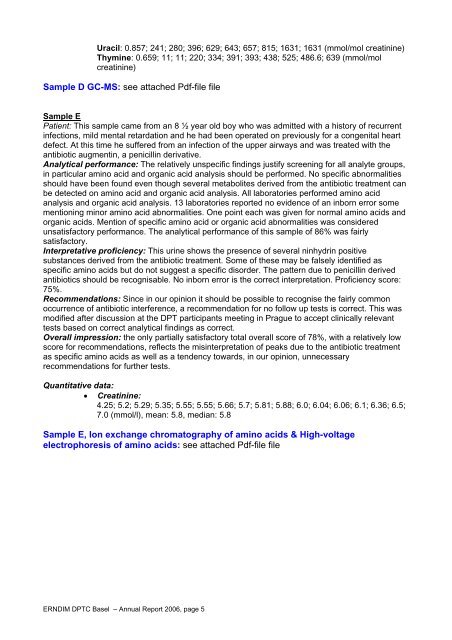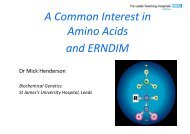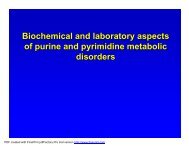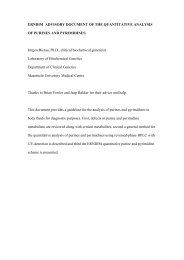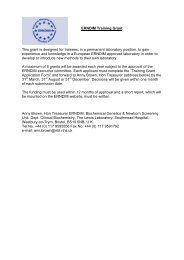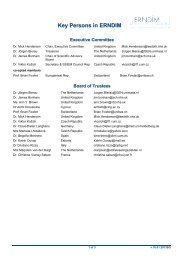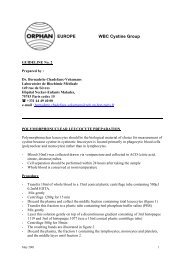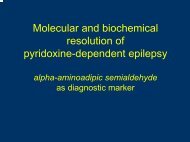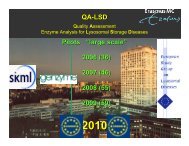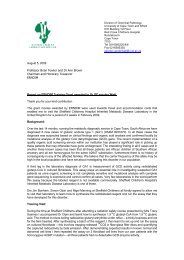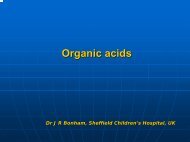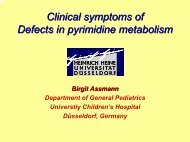DPT Report 2006 - ERNDIM
DPT Report 2006 - ERNDIM
DPT Report 2006 - ERNDIM
You also want an ePaper? Increase the reach of your titles
YUMPU automatically turns print PDFs into web optimized ePapers that Google loves.
Uracil: 0.857; 241; 280; 396; 629; 643; 657; 815; 1631; 1631 (mmol/mol creatinine)<br />
Thymine: 0.659; 11; 11; 220; 334; 391; 393; 438; 525; 486.6; 639 (mmol/mol<br />
creatinine)<br />
Sample D GC-MS: see attached Pdf-file file<br />
Sample E<br />
Patient: This sample came from an 8 ½ year old boy who was admitted with a history of recurrent<br />
infections, mild mental retardation and he had been operated on previously for a congenital heart<br />
defect. At this time he suffered from an infection of the upper airways and was treated with the<br />
antibiotic augmentin, a penicillin derivative.<br />
Analytical performance: The relatively unspecific findings justify screening for all analyte groups,<br />
in particular amino acid and organic acid analysis should be performed. No specific abnormalities<br />
should have been found even though several metabolites derived from the antibiotic treatment can<br />
be detected on amino acid and organic acid analysis. All laboratories performed amino acid<br />
analysis and organic acid analysis. 13 laboratories reported no evidence of an inborn error some<br />
mentioning minor amino acid abnormalities. One point each was given for normal amino acids and<br />
organic acids. Mention of specific amino acid or organic acid abnormalities was considered<br />
unsatisfactory performance. The analytical performance of this sample of 86% was fairly<br />
satisfactory.<br />
Interpretative proficiency: This urine shows the presence of several ninhydrin positive<br />
substances derived from the antibiotic treatment. Some of these may be falsely identified as<br />
specific amino acids but do not suggest a specific disorder. The pattern due to penicillin derived<br />
antibiotics should be recognisable. No inborn error is the correct interpretation. Proficiency score:<br />
75%.<br />
Recommendations: Since in our opinion it should be possible to recognise the fairly common<br />
occurrence of antibiotic interference, a recommendation for no follow up tests is correct. This was<br />
modified after discussion at the <strong>DPT</strong> participants meeting in Prague to accept clinically relevant<br />
tests based on correct analytical findings as correct.<br />
Overall impression: the only partially satisfactory total overall score of 78%, with a relatively low<br />
score for recommendations, reflects the misinterpretation of peaks due to the antibiotic treatment<br />
as specific amino acids as well as a tendency towards, in our opinion, unnecessary<br />
recommendations for further tests.<br />
Quantitative data:<br />
• Creatinine:<br />
4.25; 5.2; 5.29; 5.35; 5.55; 5.55; 5.66; 5.7; 5.81; 5.88; 6.0; 6.04; 6.06; 6.1; 6.36; 6.5;<br />
7.0 (mmol/l), mean: 5.8, median: 5.8<br />
Sample E, Ion exchange chromatography of amino acids & High-voltage<br />
electrophoresis of amino acids: see attached Pdf-file file<br />
<strong>ERNDIM</strong> <strong>DPT</strong>C Basel – Annual <strong>Report</strong> <strong>2006</strong>, page 5


